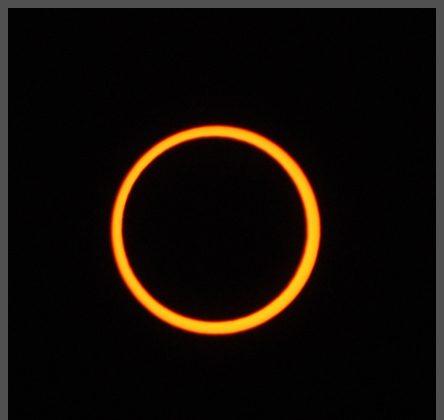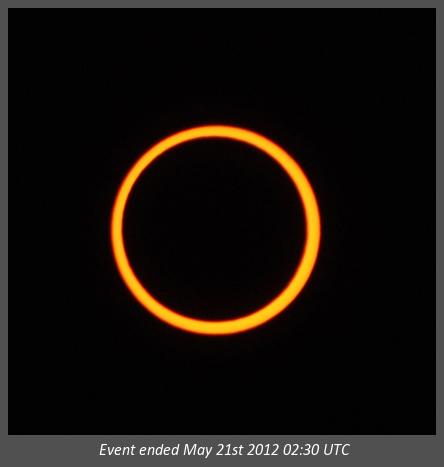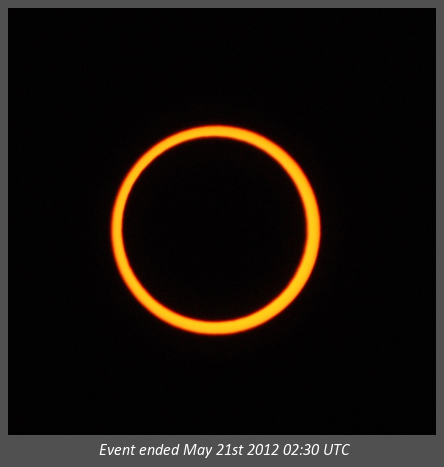Update: Slooh’s Japan feed has been canceled due to bad weather. See an alternative feed from Ustream here. Slooh’s US feeds will start at 00:00 UTC / 5 pm PDT / 8 pm EDT.
Skies in the western United States, China, and Japan will be graced by a rare and beautiful celestial phenomenon this weekend: an annular solar eclipse.
On the evening of Sunday, May 20, in the United States (the morning of Monday, May 21, in Asia), the moon will move in front of the sun, temporarily blocking up to 97 percent of its diameter and 87 percent of its light. The sky will darken, and the sun will appear as a ring of fire around a dark hole.
This will be the first time an annular eclipse has touched U.S. soil since 1994, and it won’t happen again until 2023.
An annular, or ring, eclipse is different from a total eclipse in that the moon is farther from Earth, leaving a bright ring of light around the sun’s edge instead of covering it up.
The path of annularity will include parts of Oregon, northern California, Nevada, Arizona, Utah, New Mexico, Texas, and a bit of Colorado. Inside the path, you'll be able to see the ring of fire, while outside, you may see a partial eclipse or none at all.
The closer you are to the path’s red center line, the longer the ring of fire will last—up to almost 5 minutes, according to NASA’s predictions.
Several national parks located in the path are planning events for that day, and astronomy organizations will be leading eclipse tours.
The eclipse will begin in Asia on the morning of May 21 local time, then it will cross the date line, arriving in the United States on the evening of May 20. See NASA’s interactive map here for predicted times of the eclipse at specific locations.
For over an hour, using a safe viewing method, you can watch the dark moon slowly cover the sun’s disk until together they form a bright ring in the sky. The sun won’t be completely hidden, so it is NOT safe to observe it directly. Protect your eyes with eclipse shades purchased cheaply online or solar viewing cards.
| [video]www.youtube.com/watch?v=HG5VfuqQ3O0[/video] |
Alternatively, watch the eclipse indirectly by projecting the sun’s image onto a surface. You can poke a small hole through some cardboard to create a miniature projection of the sun’s image on a surface. You can also project or view the sun with special equipment, but never look at it through a camera or telescope without solar filters.
As the eclipse becomes annular, you might notice Baily’s beads—spots of sunlight shining through deep valleys on the very edge of the moon. If you stand under a tree, you may see hundreds of tiny crescents or rings of light on the ground, formed by the same principle as the pinhole projection method via the spaces between the tree leaves.
“The sky will remain very bright so planets will not be visible,” retired eclipse expert Fred Espenak told The Epoch Times via email. “One exception is Venus which may be visible 40 degrees east of sun if sky is very clear.”
Espenak provided the eclipse predictions for this event on NASA’s website, and explained that scientists predict solar eclipses with theories that estimate the three-dimensional positions of the sun, moon, and Earth in space.
“Using those theories, you can predict the size and position of the moon’s umbral and penumbral shadows as a function of time,” Espenak said.
“Using spherical trigonometry, you can then calculate the position and speed of the moon’s shadow as it sweeps across Earth.”
See the annular solar eclipse on Jan. 4, 2011, as captured by the Hinode satellite, here.
The Epoch Times publishes in 35 countries and in 19 languages. Subscribe to our e-newsletter.






